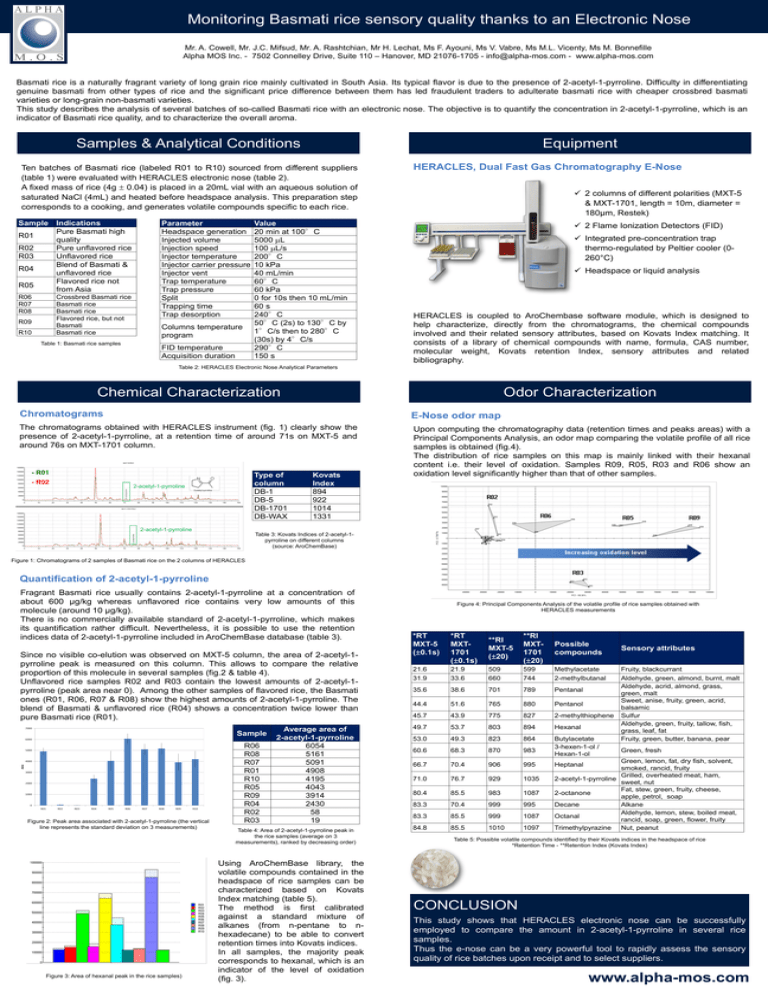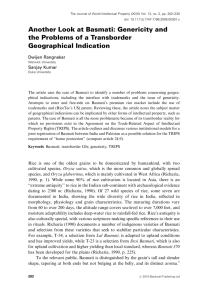Sample Average area of 2-acetyl-1-pyrroline
advertisement

Monitoring Basmati rice sensory quality thanks to an Electronic Nose Mr. A. Cowell, Mr. J.C. Mifsud, Mr. A. Rashtchian, Mr H. Lechat, Ms F. Ayouni, Ms V. Vabre, Ms M.L. Vicenty, Ms M. Bonnefille Alpha MOS Inc. - 7502 Connelley Drive, Suite 110 – Hanover, MD 21076-1705 - info@alpha-mos.com - www.alpha-mos.com Basmati rice is a naturally fragrant variety of long grain rice mainly cultivated in South Asia. Its typical flavor is due to the presence of 2-acetyl-1-pyrroline. Difficulty in differentiating genuine basmati from other types of rice and the significant price difference between them has led fraudulent traders to adulterate basmati rice with cheaper crossbred basmati varieties or long-grain non-basmati varieties. This study describes the analysis of several batches of so-called Basmati rice with an electronic nose. The objective is to quantify the concentration in 2-acetyl-1-pyrroline, which is an indicator of Basmati rice quality, and to characterize the overall aroma. Samples & Analytical Conditions Equipment Ten batches of Basmati rice (labeled R01 to R10) sourced from different suppliers (table 1) were evaluated with HERACLES electronic nose (table 2). A fixed mass of rice (4g 0.04) is placed in a 20mL vial with an aqueous solution of saturated NaCl (4mL) and heated before headspace analysis. This preparation step corresponds to a cooking, and generates volatile compounds specific to each rice. Sample Indications Pure Basmati high R01 quality R02 Pure unflavored rice R03 Unflavored rice Blend of Basmati & R04 unflavored rice Flavored rice not R05 from Asia R06 R07 R08 Crossbred Basmati rice Basmati rice Basmati rice Flavored rice, but not Basmati Basmati rice R09 R10 Table 1: Basmati rice samples Parameter Headspace generation Injected volume Injection speed Injector temperature Injector carrier pressure Injector vent Trap temperature Trap pressure Split Trapping time Trap desorption Columns temperature program FID temperature Acquisition duration Value 20 min at 100°C 5000 L 100 L/s 200°C 10 kPa 40 mL/min 60°C 60 kPa 0 for 10s then 10 mL/min 60 s 240°C 50°C (2s) to 130°C by 1°C/s then to 280°C (30s) by 4°C/s 290°C 150 s HERACLES, Dual Fast Gas Chromatography E-Nose 2 columns of different polarities (MXT-5 & MXT-1701, length = 10m, diameter = 180µm, Restek) 2 Flame Ionization Detectors (FID) Integrated pre-concentration trap thermo-regulated by Peltier cooler (0260°C) Headspace or liquid analysis HERACLES is coupled to AroChembase software module, which is designed to help characterize, directly from the chromatograms, the chemical compounds involved and their related sensory attributes, based on Kovats Index matching. It consists of a library of chemical compounds with name, formula, CAS number, molecular weight, Kovats retention Index, sensory attributes and related bibliography. Table 2: HERACLES Electronic Nose Analytical Parameters Chemical Characterization Odor Characterization Chromatograms E-Nose odor map The chromatograms obtained with HERACLES instrument (fig. 1) clearly show the presence of 2-acetyl-1-pyrroline, at a retention time of around 71s on MXT-5 and around 76s on MXT-1701 column. Upon computing the chromatography data (retention times and peaks areas) with a Principal Components Analysis, an odor map comparing the volatile profile of all rice samples is obtained (fig.4). The distribution of rice samples on this map is mainly linked with their hexanal content i.e. their level of oxidation. Samples R09, R05, R03 and R06 show an oxidation level significantly higher than that of other samples. - R01 - R02 Type of column DB-1 DB-5 DB-1701 DB-WAX 2-acetyl-1-pyrroline Kovats Index 894 922 1014 1331 2-acetyl-1-pyrroline Table 3: Kovats Indices of 2-acetyl-1pyrroline on different columns (source: AroChemBase) Figure 1: Chromatograms of 2 samples of Basmati rice on the 2 columns of HERACLES Quantification of 2-acetyl-1-pyrroline Fragrant Basmati rice usually contains 2-acetyl-1-pyrroline at a concentration of about 600 µg/kg whereas unflavored rice contains very low amounts of this molecule (around 10 µg/kg). There is no commercially available standard of 2-acetyl-1-pyrroline, which makes its quantification rather difficult. Nevertheless, it is possible to use the retention indices data of 2-acetyl-1-pyrroline included in AroChemBase database (table 3). Since no visible co-elution was observed on MXT-5 column, the area of 2-acetyl-1pyrroline peak is measured on this column. This allows to compare the relative proportion of this molecule in several samples (fig.2 & table 4). Unflavored rice samples R02 and R03 contain the lowest amounts of 2-acetyl-1pyrroline (peak area near 0). Among the other samples of flavored rice, the Basmati ones (R01, R06, R07 & R08) show the highest amounts of 2-acetyl-1-pyrroline. The blend of Basmati & unflavored rice (R04) shows a concentration twice lower than pure Basmati rice (R01). Sample Figure 2: Peak area associated with 2-acetyl-1-pyrroline (the vertical line represents the standard deviation on 3 measurements) Figure 3: Area of hexanal peak in the rice samples) R06 R08 R07 R01 R10 R05 R09 R04 R02 R03 Average area of 2-acetyl-1-pyrroline 6054 5161 5091 4908 4195 4043 3914 2430 58 19 Table 4: Area of 2-acetyl-1-pyrroline peak in the rice samples (average on 3 measurements), ranked by decreasing order) Using AroChemBase library, the volatile compounds contained in the headspace of rice samples can be characterized based on Kovats Index matching (table 5). The method is first calibrated against a standard mixture of alkanes (from n-pentane to nhexadecane) to be able to convert retention times into Kovats indices. In all samples, the majority peak corresponds to hexanal, which is an indicator of the level of oxidation (fig. 3). Figure 4: Principal Components Analysis of the volatile profile of rice samples obtained with HERACLES measurements *RT MXT-5 (0.1s) *RT MXT1701 (0.1s) **RI MXT-5 (20) **RI MXT1701 (20) Possible compounds Sensory attributes 21.6 21.9 509 599 Methylacetate Fruity, blackcurrant 31.9 33.6 660 744 2-methylbutanal 35.6 38.6 701 789 44.4 51.6 765 880 45.7 43.9 775 827 49.7 53.7 803 894 53.0 49.3 823 864 60.6 68.3 870 983 66.7 70.4 906 995 71.0 76.7 929 1035 80.4 85.5 983 1087 83.3 70.4 999 995 83.3 85.5 999 1087 84.8 85.5 1010 1097 Aldehyde, green, almond, burnt, malt Aldehyde, acrid, almond, grass, Pentanal green, malt Sweet, anise, fruity, green, acrid, Pentanol balsamic 2-methylthiophene Sulfur Aldehyde, green, fruity, tallow, fish, Hexanal grass, leaf, fat Butylacetate Fruity, green, butter, banana, pear 3-hexen-1-ol / Green, fresh Hexan-1-ol Green, lemon, fat, dry fish, solvent, Heptanal smoked, rancid, fruity Grilled, overheated meat, ham, 2-acetyl-1-pyrroline sweet, nut Fat, stew, green, fruity, cheese, 2-octanone apple, petrol, soap Decane Alkane Aldehyde, lemon, stew, boiled meat, Octanal rancid, soap, green, flower, fruity Trimethylpyrazine Nut, peanut Table 5: Possible volatile compounds identified by their Kovats indices in the headspace of rice *Retention Time - **Retention Index (Kovats Index) CONCLUSION This study shows that HERACLES electronic nose can be successfully employed to compare the amount in 2-acetyl-1-pyrroline in several rice samples. Thus the e-nose can be a very powerful tool to rapidly assess the sensory quality of rice batches upon receipt and to select suppliers. www.alpha-mos.com






